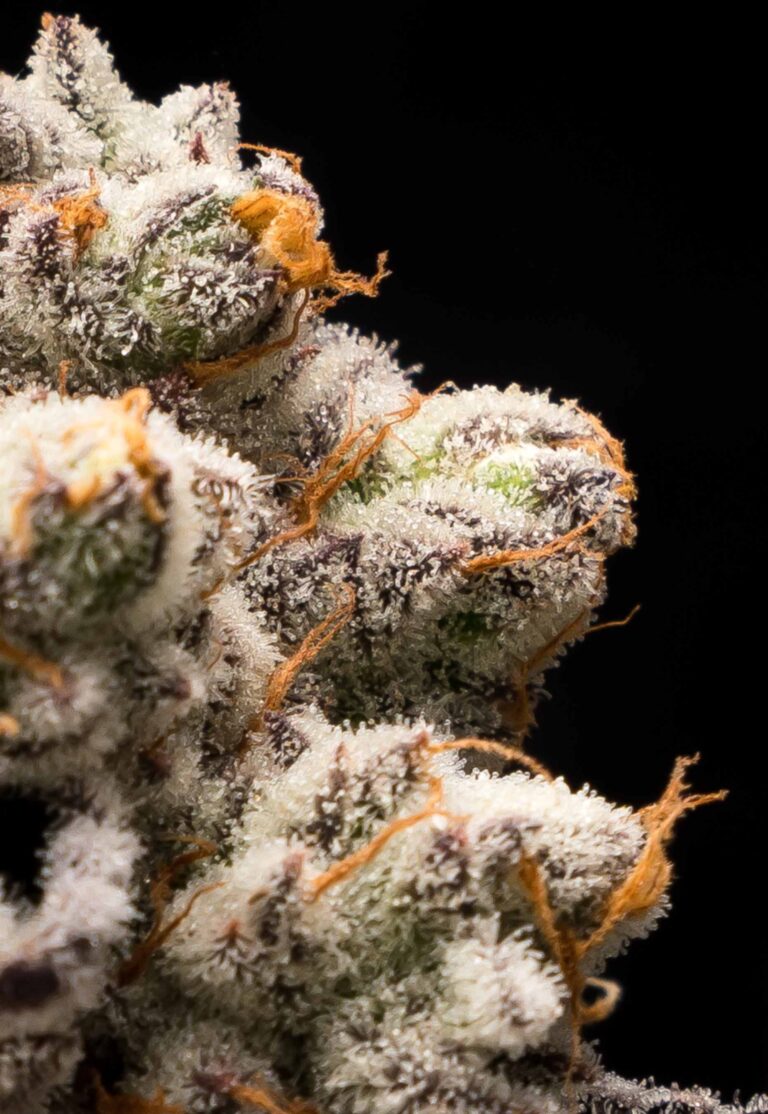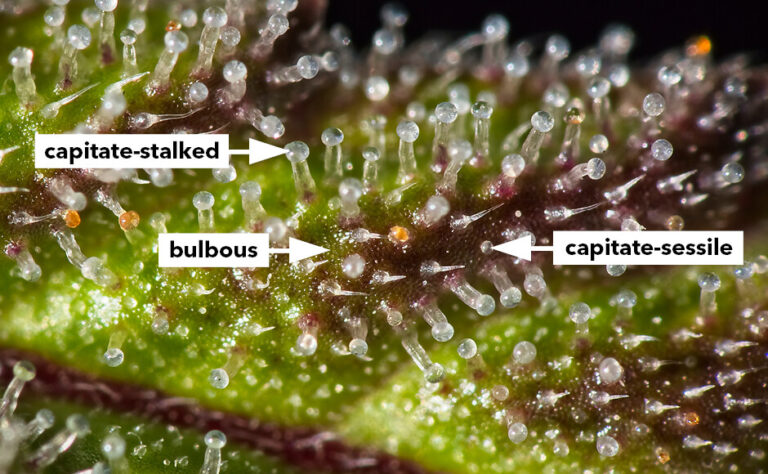What Are Trichomes? Understanding Weed Trichomes and Their Importance
We’ve all noticed the tiny, crystal-like trichomes that give cannabis its iconic frosty appearance. But what are trichomes, and what do trichomes do? Often referred to as “the crystals on weed”, trichomes play an important role in the potency and aroma of cannabis. They are not to be confused with terpenes. When you compare trichomes vs terpenes, both contribute significantly to the plant’s characteristics, which we get into later.
Historically, the word ‘trichome’ comes from the Greek word ‘Tríchōma’, meaning ‘growth of hair.’ This is due to their hair-like appearance under a microscope. The life of trichomes is fascinating and complex, just like cannabis itself. Understanding trichomes can improve your relationship with cannabis, offering you a deeper insight into the effects of the plant.
What are Trichomes in Weed?
When you ask, “What are trichomes in weed?”, the answer is surprisingly complex. Trichomes in weed are microscopic outgrowths or appendages found on the surface of the cannabis plant. They resemble tiny THC crystals on bud surfaces and serve as the main production sites for cannabinoids and terpenes. Plants with trichomes, including cannabis, use them as a defense mechanism against herbivores and damaging environmental factors.
Under a microscope, trichomes can look like a forest of miniature mushrooms. Their sticky resinous secretion is responsible for that finger-sticking sensation after handling buds. The density and arrangement of trichomes can significantly influence the visual appeal of cannabis strains. High-quality cannabis often has a dense covering of trichomes, indicating a high concentration of cannabinoids and terpenes. Now let’s find out, “What are trichomes doing”?

Why do Weed Plants Produce Trichomes?
When investigating, “What do trichomes do?”, we discover that the shining crystals on weed are more than just ornamental. Trichomes function as the plant’s defense system. They deter herbivores with their bitter taste and strong aromas, preventing them from eating the plant. The sticky texture also helps capture insects and prevent fungal growth.
When we talk about trichomes vs terpenes, it’s essential to understand that terpenes are produced within the trichomes, contributing to their protective functions. In addition to their defensive role, trichomes also help the cannabis plant survive in harsh environments by reflecting sunlight and reducing water loss.
START SHOPPING NOW
Are Trichomes Present in All Cannabis Strains?
You may wonder, “What do trichomes look like on different strains?” The answer is that weed trichomes are present in all cannabis strains. They may vary in density and size, but their presence is a universal characteristic of cannabis. Whether you’re looking at THC crystals on bud surfaces or examining plants with trichomes under a microscope, you’ll find these tiny structures in every strain.
While all cannabis strains have trichomes, not all trichomes are created equal. Some strains may produce trichomes with higher THC or CBD concentrations than others. This is why some strains are more potent or have different effects than others. It’s this diversity that makes trying different cannabis strains so exciting and rewarding.
What are the types of Trichomes in weed?
There are three main types of trichomes in weed: bulbous, capitate-sessile, and capitate-stalked. Bulbous trichomes are the smallest type, capitate-sessile trichomes are slightly larger and more abundant, while capitate-stalked trichomes are the largest and most visible to the naked eye. These are the weed trichomes responsible for the majority of THC crystals on bud surfaces and play a significant role in the trichomes function in cannabinoid and terpene production.
Even though bulbous and capitate-sessile trichomes are smaller, they shouldn’t be underestimated. They also contribute to the overall cannabinoid and terpene profile of the plant. Capitate-stalked trichomes, with their mushroom-like appearance, are the stars of the trichome show due to their size and visibility. They’re like the cannabis plant’s little factories, tirelessly producing cannabinoids and terpenes.

Trichomes Stages
Understanding the trichomes stages is good for growers aiming for optimal cannabinoid and terpene levels in their harvest. The three primary trichomes stages in weed trichomes are the clear stage (immature), the cloudy stage (peak THC levels), and the amber stage (high CBN levels). Observing the color changes in trichomes on weed and trichomes on leaves can help determine the ideal time to harvest for desired effects, whether they’re aiming for high-THC trichomes or high-CBN trichomes.
The life of a trichome from its clear stage to amber is truly a marvel of nature. The color changes reflect the maturation and transformation of cannabinoids within. This process demonstrates the dynamic nature of the cannabis plant.
Trichomes vs Terpenes: What are the differences?
When comparing trichomes vs terpenes, remember that trichomes are the structures, while terpenes are the compounds produced within them. There are other plants with trichomes, but trichomes on weed are responsible for producing cannabinoids like THC and CBD, as well as a variety of terpenes. Each cannabis strain has a unique terpene and cannabinoid profile that contributes to its aroma, flavor, and effects.
Meanwhile, THC trichomes refer specifically to trichomes rich in the psychoactive compound THC. It’s like comparing a fruit-bearing tree to the fruits it bears. Both are essential, but they play different roles. Terpenes are the unsung heroes of cannabis strains, influencing the scent and flavor of your favorite strains. So, when you find out what do trichomes do and you’re enjoying the distinctive aroma of your cannabis, don’t forget to thank those hardworking trichomes!
What do Trichomes look like when ready to harvest?
When crystals on weed begin to change color, it’s a sign that the trichomes are maturing. But what do trichomes look like when they’re ready to harvest? At peak maturity, trichomes on weed will appear milky or cloudy. As they continue to mature past this point, they’ll turn amber.
Depending on the desired effects, growers may choose to harvest at different trichomes stages. Trichomes on leaves might mature at different rates than those on buds. The art and science of harvesting based on trichome color is a skill that many cannabis cultivators take years to master. It’s like a coffee connoisseur knowing the exact moment when the beans are perfectly roasted.
What Are the Best Methods for Extracting Trichomes from Cannabis?
Now that we know what do trichomes look like, let’s talk extraction. Extracting trichomes in weed can be done using several methods, each offering different benefits. Some popular methods include dry sifting, ice water extraction, and using solvents like butane or CO2. These methods aim to separate the trichomes on leaves and buds from the plant material, resulting in potent concentrates.
Knowing the trichomes stages and trichomes function can help optimize the extraction process. Each extraction method has its pros and cons, and the choice often depends on the desired end product. For example, dry sifting is a simple and traditional method, while solvent-based extractions can yield more potent concentrates.
Understanding what are trichomes and their role in cannabis can improve your relationship with this remarkable plant. Whether you’re a grower seeking to maximize the potency of your weed trichomes or a consumer wanting to understand the source of cannabis’s effects, trichomes hold the answers. Next time you admire those sparkling THC trichomes, remember the complex processes at work within those tiny structures. For the best selection of trichome-rich cannabis, shop online or in person at Verts Neighborhood Dispensaries in Colorado, Missouri, or Traverse City, Michigan today.
Company
Shopping
Verts Neighborhood Dispensary 2024 | All Rights Reserved
